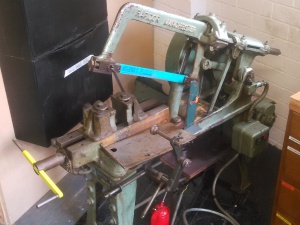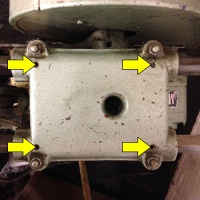Power Hacksaw

The Basics
This Rapidor Power Hacksaw, or donkey saw, is for those times when you really don't want to cut through a thick chunk of steel using a manual hacksaw. Cutting with this machine instead is slow, but effort free.
It is for cutting both ferrous and non-ferrous metals as well as plastic. Wood is better suited elsewhere because it will soak up the grease and oil that this machine spreads everywhere.
Please clean up the swarf created after you have finished cutting - wiping out the tray now is much easier than chipping it off in a few months time!
An adjustable end-stop allows for reasonably precise repeated cuts and is adjusted from both sides of the machine body.
Currently the saw has a 3 phase motor so won't work on our power. It is being converted to single phase.
Safety
- Keep away from the moving blade body.
- Do not press down on the blade body to make it cut faster.
- Do not reach underneath the propped blade body.
- Do not remove the safety covers.
- Keep fingers clear of pinch points.
- Turn the machine off before making adjustments.
Lubrication

There are four oil points on the top of the saw body which lubricate the guide rails. Place a drop of oil into each of these holes each time you use the saw to keep it running smoothly. Through the large centre hole there is access to the cam lubrication point which should be oiled regularly.
Finally, there is an oil point on each axle bearing.
There is a cam operated coolant pump built in to the saw which, when used, will prolong the life of the blades. Take note of where the coolant line is pointing (and adjust if necessary) before you turn the saw on!
We are currently looking into the best lubricant to use with this pump for the most common cutting situations.
Replacing the blade
You may need to change the blade if it breaks or you are cutting thinner/thicker material. It is held in place by wing nuts on the blade body. A good rule of thumb is this: the thinner the work you are cutting, the more teeth you need.
- Blades are 14" long, 1.25" high.
- Thickness (kerf) is typically 1.5 mm.
- Spare/different blades are kept in the groove to the left of vise.
Replacement blades are available from a variety of places, including Cromwell Tools.